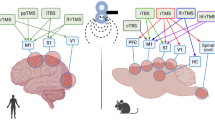The comorbidity of refractory depression and chronic pain is actively discussed in the scientific literature. The present article compares the efficacies of two TMS protocols added to drug therapy for refractory depression with comorbid chronic pain. Stimulation of the left and right dorsolateral prefrontal cortex was shown to have different effects on pain and depressive symptoms. High-frequency stimulation of the left dorsolateral prefrontal cortex was found to have progressive antidepressant and analgesic effects, while low-frequency stimulation of the right dorsolateral prefrontal cortex had a rapid analgesic effect, which decreased after completion of courses. The results obtained here clarify the neurophysiological basis of pain perception and the formation of mood in mental disorders.
Similar content being viewed by others
References
Corlier, J., Tadayonnejad, R., Wilson, A. C., et al., “Repetitive transcranial magnetic stimulation treatment of major depressive disorder and comorbid chronic pain: response rates and neurophysiologic biomarkers,” Psychol. Med., 1–10 (2021), Advance online publication, doi:https://doi.org/10.1017/S0033291721002178.
Dahlhamer, J., Lucas, J., Zelaya, C., et al., “Prevalence of chronic pain and high-impact chronic pain among adults – United States,” Morbidity and Mortality Weekly Report (MMWR), 67, No. 36, 1001–1006 (2018).
de Zwart, P. L., Jeronimus, B. F., and de Jonge, P., “Empirical evidence for definitions of episode, remission, recovery, relapse and recurrence in depression: a systematic review,” Epidemiol. Psychiatr. Sci., 28, No. 5, 544–562 (2019).
Delgado, D. A., Lambert, B. S., Boutris, N., et al., “Validation of digital visual analog scale pain scoring with a traditional paper-based visual analog scale in adults,” J. Am. Acad. Orthop. Surg. Glob. Res. Rev., 2, No. 3, e088 (2018).
Hamid, P., Malik, B. H., and Hussain, M. L., “Noninvasive transcranial magnetic stimulation (TMS) in chronic refractory pain: A systematic review,” Cureus, 11, No. 10, e6019 (2019).
Herrmann, N., Black, S. E., Lawrence, J., et al., “The Sunnybrook Stroke Study: A prospective study of depressive symptoms and functional outcome,” Stroke, 29, No. 3, 618–624 (1998).
Khera, T. and Rangasamy, V., “Cognition and pain: A review,” Front. Psychol., 12, 673962 (2021).
Koerselman, F., Laman, D. M., van Duijn, H., et al., “A 3-month, follow-up, randomized, placebo-controlled study of repetitive transcranial magnetic stimulation in depression,” J. Clin. Psychiatry, 65, No. 10, 1323–1328 (2004).
Köhler, S., Chrysanthou, S., Guhn, A., and Sterzer, P., “Differences between chronic and nonchronic depression: Systematic review and implications for treatment,” Depress. Anxiety, 36, No. 1, 18–30 (2019).
Lefaucheur, J. P., Aleman, A., Baeken, C., et al., “Evidence-based guidelines on the therapeutic use of repetitive transcranial magnetic stimulation (rTMS, An update (2014–2018),” Clin. Neurophysiol., 131, No. 2, 474–528 (2020).
Li, J. X., “Pain and depression comorbidity: a preclinical perspective,” Behav. Brain Res., 276, 92–98 (2015).
McClintock, S. M., Reti, I. M., Carpenter, L. L., et al., “Consensus recommendations for the clinical application of repetitive transcranial magnetic stimulation (rTMS) in the treatment of depression,” J. Clin. Psychiatry, 78, 35–48 (2018).
Mills, S., Nicolson, K. P., and Smith, B. H., “Chronic pain: a review of its epidemiology and associated factors in population-based studies,” Br. J. Anaesth., 123, No. 2, e273–e283 (2019).
Pallanti, S., Di Rollo, A., Antonini, S., et al., “Low-frequency rTMS over right dorsolateral prefrontal cortex in the treatment of resistant depression: cognitive improvement is independent from clinical response, resting motor threshold is related to clinical response,” Neuropsychobiology, 65, No. 4, 227–235 (2012).
Ragimova, A. V., Petelin, D. S., Zakharova, N. V., et al., Application of Transcranial Magnetic Stimulation in Psychiatric and Neuropsychiatric Practice, Central State Medical Academy of the Office of the President of the Russian Federation (2019).
Roughan, W. H., Campos, A. I., García-Marín, L. M., et al., “Comorbid chronic pain and depression: Shared risk factors and differential antidepressant effectiveness,” Front. Psychiatry, 12, 643609 (2021).
Seminowicz, D. and Moayedi, M., “The dorsolateral prefrontal cortex in acute and chronic pain,” J. Pain, 18, No. 9, 1027-1 (2017).
Shah, D., Allen, L., Zheng, W., et al., “Economic burden of treatment-resistant depression among adults with chronic non-cancer pain conditions and major depressive disorder in the US,” Pharmacoeconomics, 39, No. 6, 639–651 (2021).
Somani, A. and Kar, S. K., “Efficacy of repetitive transcranial magnetic stimulation in treatment-resistant depression: the evidence thus far,” Gen. Psychiatr., 32, No. 4, e100074 (2019).
Tanwar, S., Mattoo, B., Kumar, U., and Bhatia, R., “Repetitive transcranial magnetic stimulation of the prefrontal cortex for fibromyalgia syndrome: A randomised controlled trial with 6-months follow up,” Adv. Rheumatol., 60, No. 1 (2020).
Ullrich, H., Kranaster, L., Sigges, E., et al., “Ultra-high-frequency left prefrontal transcranial magnetic stimulation as augmentation in severely ill patients with depression: A naturalistic sham-controlled, double-blind, randomized trial,” Neuropsychobiology, 66, 141–148 (2012).
Voineskos, D., Daskalakis, Z. J., and Blumberger, D. M., “Management of treatment-resistant depression: Challenges and strategies,” Neuropsychiatr. Dis. Treat., 16, 221–234 (2020).
Zhao, X., Li, Y., Tian, Q., et al., “Repetitive transcranial magnetic stimulation increases serum brain-derived neurotrophic factor and decreases interleukin-1β and tumor necrosis factor-α in elderly patients with refractory depression,” J. Int. Med. Res., 47, No. 5, 1848–1855 (2019).
Zimmerman, M., Chelminski, I., and Posternak, M., “A review of studies of the Montgomery–Asberg Depression Rating Scale in controls: Implications for the definition of remission in treatment studies of depression,” Int. Clin. Psychopharmacol., 19, No. 1, 1–7 (2004).
Author information
Authors and Affiliations
Corresponding author
Additional information
Translated from Zhurnal Vysshei Nervnoi Deyatel’nosti imeni I. P. Pavlova, Vol. 72, No. 5, pp. 717–727, September–October, 2022.
Rights and permissions
Springer Nature or its licensor (e.g. a society or other partner) holds exclusive rights to this article under a publishing agreement with the author(s) or other rightsholder(s); author self-archiving of the accepted manuscript version of this article is solely governed by the terms of such publishing agreement and applicable law.
About this article
Cite this article
Petelin, D.S., Bezrukov, V.E., Shishorin, R.M. et al. Comparison of the Effectiveness of Transcranial Magnetic Stimulation Protocols as an Adjunct to the Pharmacotherapy of Refractory Depression with Comorbid Chronic Pain. Neurosci Behav Physi 53, 365–372 (2023). https://doi.org/10.1007/s11055-023-01435-3
Received:
Accepted:
Published:
Issue Date:
DOI: https://doi.org/10.1007/s11055-023-01435-3




